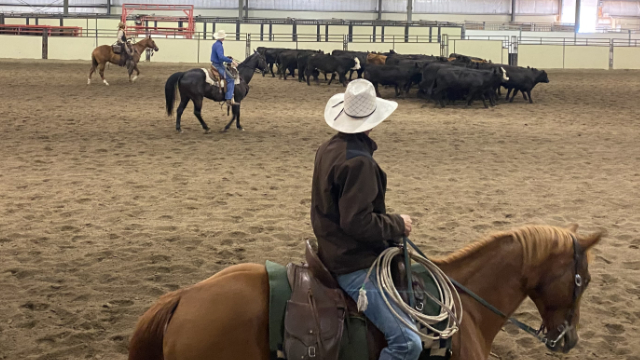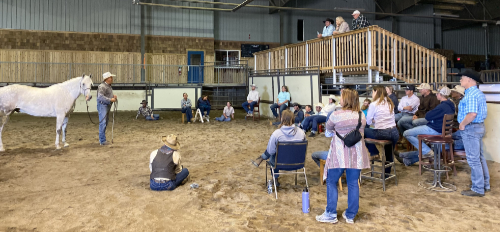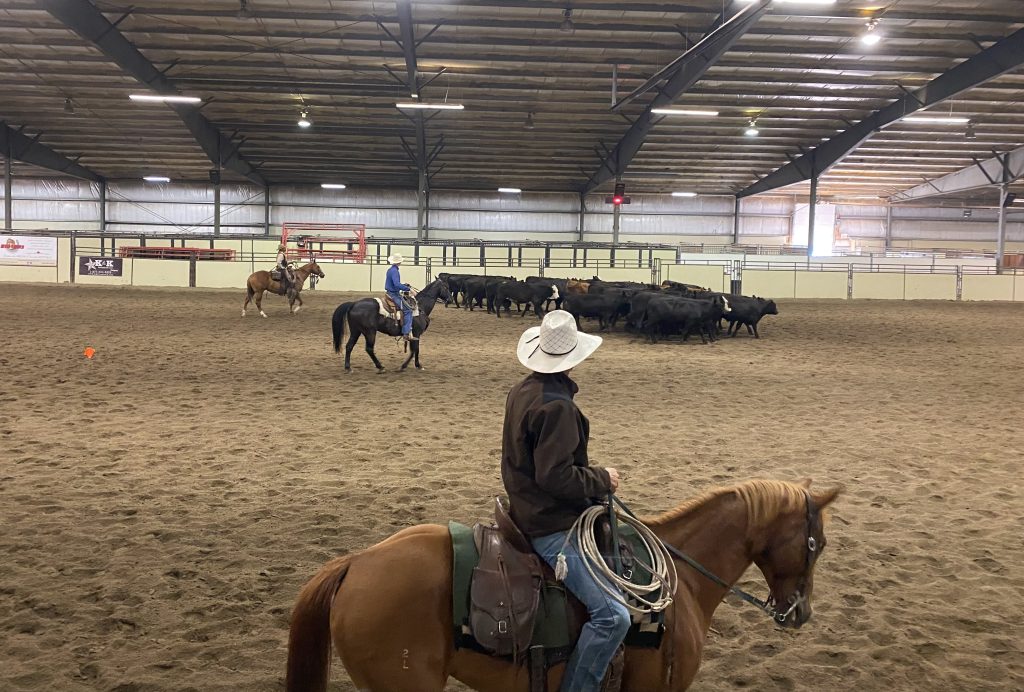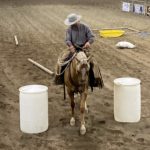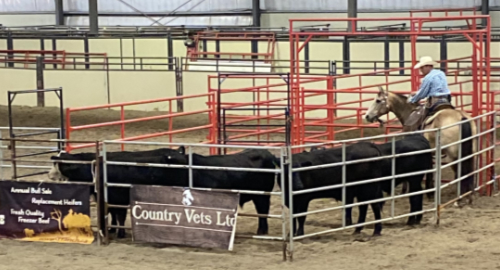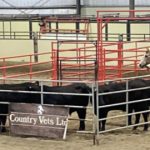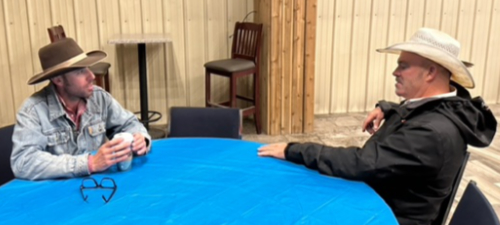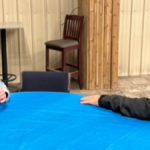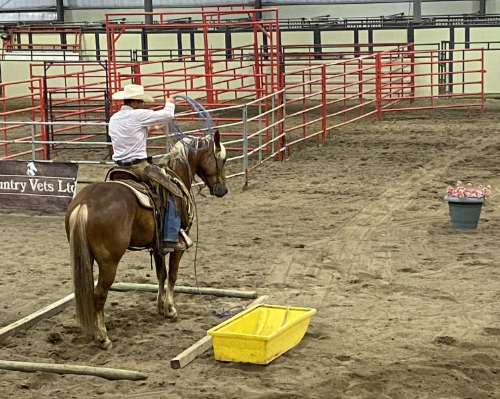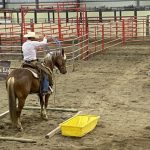In 2022 a unique contest was hosted by Malcolm and Jenny MacLean at the Pincher Creek Rodeo Grounds in Alberta, Canada, in conjunction with a stockmanship school to introduce people to the low-stress livestock handling methods developed by Bud Williams. The school and competition were well received so the goal was to make this an annual event.
The 2nd Annual Ultimate Stockmanship Challenge was held July 12-15, 2023 at the Silver Slate indoor arena in Nanton, Alberta, as a three-day school, followed by the stockmanship competition July 15th. The competitions included on-foot and horseback categories.
Malcolm MacLean put the first Stockmanship Challenge together because he could not find another event that represented the skills of a true stock person. “A truly good stockman has the ability to get the job done without adding undue stress to stock, because he/she understands cattle behavior, and doesn’t need to use intimidation. These stockmen use proper positioning, and have the ability to read cattle,” said MacLean.
The Ultimate Stockmanship Challenge is judged on efficiency of completing tasks and on the stress level of cattle. “The events are tailored to be a reflection of real life feedlot, ranch, or pasture work–working with groups of cattle by yourself. You can generally get away with using fear and intimidation on a single animal by yourself. This is why in our competitions we have just a single person (with or without a horse) working with a group of cattle instead of teams of people working with a group of cattle, or a single person working with a single animal,” he said.
Glenn Stewart, a Natural Horsemanship Clinician and Horse Specialist (based in British Columbia), was one of the instructors and also a judge in this year’s event. “I was asked to do the horsemanship clinic and set up the horsemanship part of the competition.
I’ve been teaching horsemanship all over the world for 20-some years. Many people do a lot of their cattle work with horses, and this is why I got asked to come—to help with the horsemanship part of it, to talk about what they might need their horses to be able to do in order to handle cattle better,” he said.
“I didn’t have much time to help them with their horsemanship but enough to raise more awareness. It was the fire-hose treatment—giving the participants many things to briefly try, think about and consider how horsemanship will help their stockmanship. I generally teach 4 to 5-day clinics (6 hours a day) so what we did here barely touched the tip of the iceberg. I covered a few areas and gave tips on how you might improve your turns, back up, being able to move the horses body parts separately and build a calm, thinking horse that understands what’s being asked, and how to ask. It’s challenging to handle cattle well without these basics,” he said.
“Your horse will end up pushing on cattle when you don’t want to because of the way he turns, or he won’t back up or back up fast enough.” You will be sending the wrong signal to the cattle.
“If you touch the reins and the horse’s head flies up, or he’s bouncing all around and can’t stand still, or if he moves too quickly or can’t move quick enough, any of those things will make proper cattle handling more challenging,” said Stewart.
“The Bud Williams philosophy of cattle handling fits right in with the type of horsemanship I teach.” The horsemanship part of this contest was set up to test the maneuverability of the horse, and each contestant had to accomplish it in a certain amount of time.
“It wasn’t like they had to gallop around and go fast. It was set up to see if the horse can be responsive even at a walk, and whether the riders know what a diagonal is and how to ask and get a right and left lead,” said Stewart.
“I basically set it up to test your sideways, your back-up, and whether your horse can stand still, or maneuver through little obstacles, and how he works a rope. Can you move your horse around and drag something—and not just a straight line but maybe weave through a pattern? We had some different obstacles and tasks to complete, some trees set up and a little bridge. The horse had to ground tie, side-pass over a pole, etc. and do things I would expect any ranch horse should be able to do. I didn’t make it real tough; it was an easy course, by my standards, but I tried to cover the basics that any horse should be able to do if you are going to work cattle and have much success, and make your day in the saddle more enjoyable and not just be stampeding cattle,” he said.
“Horses get good at what we do with them so they might be good at mud holes and creek crossing which will get you from point A to B–but they might be nervous while sorting cattle and might not move their hips or be able to move the front end and go sideways or back up real well.”
When you are moving or sorting cattle, being able to precisely position your horse in response to the cattle is important. Your horse’s body language is crucial. It’s more important that your horse can move various parts of his body as you direct him than whether he can go through creeks or a mud-hole—as far as the cattle are concerned.
“We weren’t out in the bushes or mud for this contest, but I suspect that a lot of the horses might have been better at that than what I was asking of them, which was particular movements, separating the parts and pieces of the horse and being able to direct those parts. The whole point was to try to shine a light on why, what and how things could be improved, and everyone was eager to learn,” he said.
“We had some rope work in the competition which I thought everyone would have no problem with but some horses were not having any part of the tasks I set out. I brought one of my horses and showed how particular, precise and responsive a horse can be even at liberty with the horse completely free. If you set your horse and yourself up for success and you are both prepared, going to work every day with cattle is peaceful and easy–which keeps weight on the cattle and money in the rancher’s pocket.”
“If you prepare your horse and yourself for the job, and prepare the cattle, it’s easy. You can train cattle, you can train horses, and train people.” People are usually very direct-line thinkers, however, and just go for it—which means nothing has been prepared—not the horses or the cattle. Things can be so much easier if there’s been some preparation and the cattle and horses know how to respond.
“It may take a couple hours out on the trail to get that horse settled down. I tried to show them that it doesn’t need to be that way and some of the things to work on even for 10 minutes before heading out. That’s what my part was, in this event,” he said.
“I’ve been around cattle and helping ranchers, but most if not all have never seen or heard about what was being taught at this clinic,” said Stewart. Usually the ranch work is more like a rodeo and isn’t very easy on the cattle, the horses, or the cowboys.
“The kind of cattle handling taught at this event is dramatically different from what I see at most ranches I’ve been on. In earlier days we had cattle ourselves and didn’t know anything about this, either. When I met Malcolm he said the horsemanship I was teaching had the same approach and philosophy as what they were teaching with cattle handling. What I consider true horsemanship is aligned very closely with this kind of cattle handling,” Stewart said.
Cattle are just as trainable as horses, but most people never think about that. Even good horsemen, who know a lot about training horses, rarely carry this kind of thinking over into how they work cattle. It’s as if a cow is a “dumb brute” and they have to ram and jam the cattle to get the job done.
“In all the years I’ve been going around to ranches, helping with branding and processing cattle, I never heard anyone say, ‘Let’s train the cattle.’ Yet they are easy to train.” A person has to know how to do it, however, and be consistent and give the cattle a chance to be trained.
“Humans are born with predator instincts. This usually messes up the way we tend to work with horses and it really messes up things with cattle. We have direct-line thinking and this doesn’t work very well with cattle, or horses. It’s a matter of catching yourself and realizing you are slipping back into predator mode and need to slow down and take a different approach,” said Stewart.
“I loved helping with this stockmanship challenge. The speakers were good, and Dawn Hnatow was fantastic. She really knows her business, handling cattle.” This is the best way to handle them.
“Last fall I got invited to round up cattle from a big mountain pasture and it was a nice approach—going through the hills and bush with no stress at all. No one was running around or trying to head the cattle off. Some of the guys with us were wanting to go chase some and were looking at us as if we’d lost our minds because we were not panicking about it, and everything went very smoothly. This was a huge contrast to the way I seen it done on other ranches,” he said.
“It’s can be shocking the way many people do it, on so many levels. It’s equally amazing, in terms of how nice your cattle can be to handle if you do it right.” There is less shrink, if you are selling them, less wear and tear on facilities, less labor needed. A person can save money in many ways, if they handle cattle properly.
“I’ve watched owners run their cattle down the alley, jam them down the chute, screaming like crazy, waving sticks and using a stock prod—and cattle are running everywhere. At the chute everyone is lined up poking and stabbing cattle as they are running into the squeeze and banging their hips and shoulders. Cattle are being bruised and battered, banging off the alleyway and metal squeeze. It’s stressful for everyone but they don’t seem to consider any other approach,” said Stewart.
“One time we went into a pasture where 10 bulls needed to be pulled out from the cows; my friend asked if I’d like to come and help. I asked how long it would take and he said that if things went well they’d get one bull that day, and one more the next day, and maybe in a couple weeks they’d have them all out. I asked why they could only get one a day, and how far are they from the corral? He said they were fairly close, in just a half section of pasture. I asked why they would only get one and he said the bulls get on the fight–and when I got there I could see why those bulls get on the fight!
“I asked if I could make some suggestions on how they were going about it—and we got nine of the bulls that first day. They did mess up on one and he did get on the fight, but they’d never been able to get nine in one day.”
The way many people handle cattle is wild and crazy and gives ranching a bad image–and at the end of the day it costs the owner money. Many ranchers have never seen a better way. “My family had cattle for 30 years, and as I was growing up I did things the same way I’d seen. It’s just in the last few years that I’ve made a point of being around people like Malcolm and Dawn and learning as much as possible, which is very different than what I’d seen in the past,” Stewart said.
“There is always so much to learn, so why not make a point of learning more about what we do, rather than think we know. Working with the mind of a single cow or a herd, there is more to it than whooping and hollering. Sometimes we humans are not as smart as we think we are!”
Malcolm MacLean said the difference between low stress/proper stockmanship (or whatever you want to call it) and conventional cattle handling is learning and understanding that we humans are predators by nature. “Instinctively, we work livestock this way. By understanding our innate behavior and the cattle’s innate behavior, we can begin to understand how to work with the cattle instead of against the cattle. This takes the stress off cattle, so they are able to easily understand what they are being asked to do,” said MacLean.
This also applies to horsemanship. “Something Glenn Stewart told me is that ‘because we are predators by nature, our hands on the rein close fast, and open slow – like a predator grabbing its prey. We need to learn to close our hands slow and open them fast’. This means we need to apply pressure slowly, but take pressure off quickly, instead of applying pressure quickly, and taking it off slowly. It’s not the pressure that teaches, but the release of pressure that teaches,” he explained.
One of the major differences between the two types of cattle handling is a person’s mindset. “It is absolutely necessary to have the mindset of not blaming the cattle or the horses. It is understanding that the animals are only doing what they are doing as a reflection of how they are being asked to do it.”
[ux_product_categories number=”10″ parent=”0″ columns=”4″ title=”Our categories” ]

